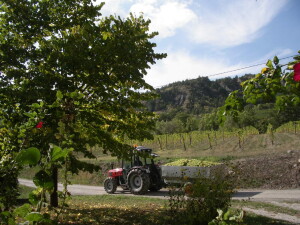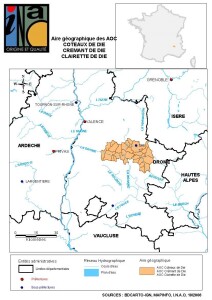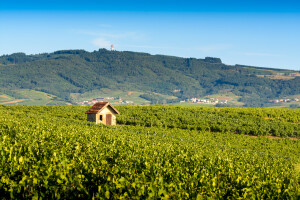According to an old legend, thousands of years ago a Gallic shepherd was placed a bottle of local wine in the cold, winter waters of the Drôme River in order to cool the wine. The shepherd became distracted and forgot about the bottle, only to re-discover it several months later. When he opened the wine, he was met with a delightful spray of spritz; the wine had become lightly carbonated as the waters warmed up in the spring.
Many years later, distant relatives of that first Gallic shepherd can drink the same type of wine, now called Clairette de Die. The vineyards of Die are located about 30 miles east of the Rhône River, at just about the spot where the Northern and Southern sections of the Rhône Valley meet. This section of the French département of the Drôme, actually part of the Rhône Valley wine region, is home to four distinct AOCs.
To make authentic Clairette de Die, the grapes are pressed immediately after harvest and placed in vats to ferment at very low temperatures, replicating the process used in ancient times when jugs of wine were kept in the icy waters of the local rivers. After one or two months of slow fermentation, the sweet, still-fermenting wine is bottled. The bottles are kept at a constant temperature of about 50°F and the wine is allowed to continue fermenting for another four months. Fermentation ends naturally when the wine is still slightly sweet. The wine is usually clarified by being emptied and quickly re-filled (this is the ancient method, after all). This method of making Clairette de Die, based on the tradition founded 2,000 years ago, was officially recognized as the “ancestral dioise process” in 1941, and considered unique to this area.
There are four AOC’s in the Pays Diois:
Clairette de Die AOC, the most famous of the wines, is a low-alcohol (about 8%), semi-sweet, slightly sparkling wine made using the officially recognized “ancestral dioise process.” Clairette de Die is made from the Muscat Blanc à Petits Grains (75% minimum) and Clairette (25% maximum) grape varieties. Look for aromas and flavors of apricot, peach, tropical fruit, citrus, honeysuckle and white rose.
Crémant de Die AOC, a Traditional Method sparkling wine, historically produced from 100% Clairette, is now made with a Clairette/Aligoté/Muscat blend. This wine is dry and crisp with aromas and flavors of apple and green fruit.
Coteaux de Die AOC is a still, dry white wine made from 100% Clairette grapes. The annual production is quite low…only around 1,500 cases, so you’ll most likely have to take a trip to the Diois for a sip!
Châtillon-en-Diois AOC is a still wine made in white, red, and rosé. The red and rosé versions, produced from Gamay, Pinot Noir, and Syrah, are only made in the vineyards immediately surrounding the village of Châtillon-en-Diois. The more widely available white version, made from the Aligoté and Chardonnay grapes, is produced throughout the Pays de Diois region.
It’s a tricky word, to be sure. Those in the area pronounce Diois as “dee-wah”. Say it right, and you’re halfway there.
References/for more information:
- Cahier de Charges – Chatillon en Diois AOC
- Cahier de Charges – Coteaux de Die AOC
- Cahier des Charges – Clairette de Die AOC
- Cahier des Charges – Cremant de Die AOC
- Tech Sheet for Clairette de Die via Jaillance


